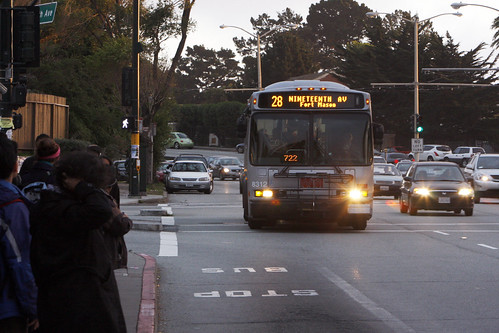
The long journey to and from school may get shorter next year as Muni pursues a series of proposals to cut travel time along 19th Avenue.
The proposed changes are part of Muni’s ongoing Transit Effectiveness Project, which started in 2008 and aims to improve reliability and efficiency on some of the city’s most congested routes.
“We’re trying to find cost-effective ways to increase service and identify problem areas,” said TEP Project Manager Julie Kirschbaum. “There is no single magic way to make the buses and trains faster; it’s a package of treatments that we hope to implement throughout the route.”
The treatments include giving buses priority at traffic signals, all-door boarding so passengers can legally enter through the back door, and extending the sidewalk in a few select locations so buses won’t have to merge in and out of traffic every time they stop. The sidewalk extensions would also increase safety by shortening the distance pedestrians have to travel when crossing 19th Avenue.
The 3.4 mile stretch of 19th Avenue, between Junipero Serra Boulevard in the south and Lincoln Way in the north, is one of the city’s most congested thoroughfares with more than 90,000 vehicles traveling the route on an average weekday.
News of improvements is welcomed by students who rely on Muni to get them to class on time.
“It’s generally pretty reliable,” said SF State international business major Otter Cole, who rides the 28 at least twice a day. “But I’m never surprised when it screws me over. It’s definitely not the most efficient system on the planet.”
Though most students seemed satisfied with the current level of service, almost all said that Muni had lots of room for improvements.
“It seems like there’s a lot of lag time between buses,” said Michelle Quintara, an art major. “It’s a huge pain. Everybody has to get here one way or another and service gets pretty spotty when you move away from downtown.”
Besides giving buses signal priority by outfitting them with GPS trackers that can communicate with traffic lights, SFMTA is also considering a handful of other changes including transit-only lanes and removal and consolidation of some stops.
“By eliminating certain stops, we think we can improve travel time,” Kirschbaum said. “A small portion of our customers may have to walk a bit farther to get to a stop, but they’ll have a quicker ride once they’re on the vehicle.”
Cole agreed that some of the stops seem unnecessary.
“It does seem like there are some redundant stops,” he said. “A little bit of a farther walk seems like a fair trade-off for a shorter trip.”
The SFMTA hosted a community outreach meeting late last month to gauge public reaction to the proposals so that Muni riders had a chance to weigh in.
“This is something we want to do very thoughtfully,” Kirschbaum said. “Being mindful of transfer points and locations of things like senior centers.”
There are currently 22 bus stops in either direction along the affected area of 19th Avenue with an average distance of 680 feet between them. The proposed changes, if implemented, would increase that distance to 1,240 feet.
“One of the unique things about Muni is that we have a very high density of stops,” said Dustin White, a planner with the SFMTA. “Most people can walk out their door and be a pretty short distance from a stop. It makes for a very accessible system, but it also contributes to longer travel times.”
Buses currently spend more than 50 percent of their time at a dead stop, either picking up passengers or waiting for traffic signals, according to White.
The 28 presently operates at an average of 9.9 miles per hour on 19th Avenue. If all of the proposed changes are adopted, the SFMTA estimates it could increase that number to 13.3 miles per hour, shaving roughly 11 minutes, or 26 percent, off the average trip.
Increasing speed and reliability are important steps moving forward, according to Kirschbaum, because when people opt out of public transit it affects everyone on the road.
“When transit doesn’t work, people find other ways to get around,” she said. “When people leave transit and start driving, it creates a vicious cycle. More cars means more congestion, and then we’re back where we started.”
While nearly all of the improvements are focused on the 28, the proposed elimination of one of the two northbound left turn lanes at Winston Drive would also increase efficiency on the M metro line.
The SFMTA will be hosting community outreach meetings throughout the spring to discuss changes on all of the affected routes and plan to release an official study by early summer.



